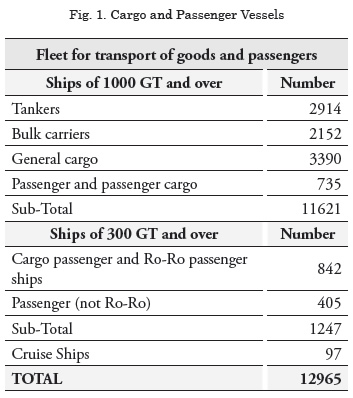
The Most Recent Noise & Vibration Assessment of the European Fleet, within the Framework of the “SILENV Project”
La evaluación de ruido y vibraciones más reciente de la flota europea dentro del marco de trabajo del “Proyecto SILENV”
Publio Beltrán Palomo1
Abstract
The EU’s new “Green Policy” to reduce the environmental impact of all types of vessels is generating new Directives that shall affect the Shipbuilding Industry. As a direct consequence, an intense debate has been opened with the participation of all the players involved: the European Commission, Marine Institutions, Shipbuilding Industry, Marine Sector, and Scientific Community. Participation of the authors in the SILENV, BESST, and AQUO projects within the FP7 has permitted noticing that for the complete assessment of the ships’ environmental impact it is essential to introduce the new so-called Noise & Vibration – Full Signature indicator. In addition to the well-known topics of Noise & Vibration (N&V) on board, it includes new ones: Noise Radiated to Harbour and Underwater Radiated Noise (URN) by the ships. Both, but especially the latter (URN) became the most outstanding novelty and the biggest challenge to be technically solved. In this sense, it is essential to know the “Starting Point”: How far is the current European Fleet from the Standard Regulations and from other Directives that will soon be compulsory? And which are the technical reasons and root causes of these deviations? To address these issues within the framework of the SILENV Project, the most recent N&V database compiled with 171 ships from the European Fleet and 12,000 N&V experimental data have been assessed. It became the largest ever N&V database in the marine sector, as well as a complete novelty. Therefore, the results, conclusions and recommendations obtained from it are of paramount importance to support current policies of the EC and other Marine Institutions that focus their efforts on combating the environmental impact of the ships.
Key words: Noise, Vibration, Noise radiated to harbour, Noise radiated to the water, Underwater footprint
Resumen
La nueva Política Verde de la Unión Europea de reducir el impacto ambiental de todo tipo de buques, está generando nuevas directrices que afectarán a la industria de la construcción naval. Como consecuencia, un intenso debate se ha abierto con la participación de todos los actores: la Comisión Europea (EC), Instituciones Marítimas: ILO e IMO, la Industria de la Construcción Naval Astilleros, el Sector Marítimo y la Comunidad Científica. La destacada participación del autor en los Proyectos de Investigación BESST, SILENV y AQUO dentro del 7º Programa Marco (FP7) ha puesto de manifiesto que la evaluación del “impacto ambiental” de un buque requiere la introducción de un nuevo “indicador” llamado “Firma Acústica del Buque”. Dicho indicador incluye además de los ya conocidos Ruidos y Vibraciones a bordo, los nuevos aspectos como son: el Ruido Radiado al Puerto y el Ruido Radiado al Agua por el buque. Estos dos últimos aspectos, pero especialmente el último, se ha convertido no sólo en la más destacable novedad, sino en un gran reto técnico que se debe resolver. En este sentido, es esencial conocer el “punto de partida”: ¿Cómo se encuentra la Flota Europea con respecto a las Regulaciones Estándar y a las nuevas Directrices que, de forma inmediata, serán obligatorias?, y ¿Cuáles son las razones técnicas y causas originarias de estas desviaciones? Para responder a estas inquietudes, dentro del marco del proyecto SILENV, la Base de Datos más reciente integrada por más de 171 buques de diferentes tipos de la flota europea y 12.000 datos experimentales, ha sido evaluada. Ello la convierte en la base de datos experimental más extensa dentro del sector marítimo además de una reciente novedad. Los resultados y conclusiones obtenidas se revelan de gran importancia para soportar las políticas actuales de la EC y otras instituciones marítimas en el reto de reducir el impacto ambiental de los buques.
Palabras claves: Ruido, Vibración, Ruido radiado a puerto, Ruido radiado al agua, Firma acústica submarina
Date Received: September 28th, 2012 - Fecha de recepción: 28 de Septiembre de 2012
Date Accepted: March 6th, 2013 - Fecha de aceptación: 6 de Marzo de 2013
________________________
1TSI-Técnicas y Servicios de Ingeniería. Naval Architect & Marine Engineer- TSI´s Director. Madrid, España. e-mail: publiobp@tsisl.es
............................................................................................................................................................
Nomenclature
N&V: Noise and Vibration
IMO: International Maritime Organization
ISO: International Standard Organization
EC: European Commission
NRH: Noise radiated by the vessels to harbour
URN: Underwater Radiated Noise by the vessels
FP7: Seventh Frame Programme on Research and Development
N&V-FS: N&V full signature of the vessel;
includes N&V on board, NRH, and URN for
each vessel
BESST project: Breakthrough in European Ship and Shipbuilding Technologies
SILENV project: Ship-oriented Innovative solutions to reduce Noise & Vibrations
PSL: Preliminary SILENV target limits
Introduction
Noise and vibrations (N&V) induced by different N&V sources on board vessels have been among the most recurrent issues in the shipbuilding industry. Its trend over time and its presence and request in the contract specifications, always related to the state-of-the-art, has been widely changed. Thus, in the contract specifications of the 70s, references to vibration were few and consisted of ambiguous quotes such as “the shipyard will do its best to reduce noise and vibration on board”. At this time, this ambiguity, as well as the absence of clear and well-established limits for both topics (noise and vibration), generated different opinions: from the owner’s point of view, the vessels had high vibration levels, but from the shipyard’s point of view these were barely perceptible. Reaching agreement was, therefore, difficult. It is important to mention that at that moment the risk of having high vibration on board was increasingly higher due to several aspects such as the optimization of the scantling of the vessels, their larger size, and more powerful engines installed.
At the beginning of the 80s, with the appearance of the IMO A.468 (XII) Noise Resolution [4] and ISO 6954-1984 Standard [5], related to vibration on board, said uncertain scenario changed drastically. At that moment, the noise and vibration assessment could be performed objectively and impartially and, more importantly, based on contractually defined noise and vibration limits. In any case, as can be seen in the corresponding paragraphs related to the scopes and fields of application of both standards, if the ship is under 1,600 tons of gross tonnage, it is exempted from complying with the noise standard, and if the vessel is under 100 m, it is exempted from complying with the vibration standard. This clearly means that practically all fishing vessels and most of the small merchant vessels were outside all N&V regulations. Particularly, the IMO Resolution stated that the Code is not applicable to fishing vessels, among others. Furthermore, it also explains that “the Code should apply to new ships under 1,600 tons gross tonnage, as far as reasonable and practicable, to the satisfaction of the Administration”. These deliberate exceptions would have been related to the N&V state-of-the art of that moment. Also, it is important to point out that at that time there was an extended belief on the impossibility of mitigating noise in fishing vessels because they were “noise boxes”. In fact, the belief was so deeply-rooted that even when the chief engineer was sleeping next door to the main diesel engine room, no actions were taken. The dramatic consequences of this absence of regulations arose quickly: several dedicated investigations have highlighted the high percentage of hearing loss and injuries among crew members and the negative effects on their health. However, and despite these absences, it is essential to highlight the excellent role played by these N&V standards on the sensitization of the shipbuilding industry and owners, which took a first step on the abatement or mitigation of N&V on board.
If we take into account the great growth that the cruise market has experienced during the last two decades (146%), and the companies’ point of view (which are convinced that the passengers choose a cruise evaluating both safety and comfort), it is obvious to point out that cruise liners are the vessels that have made the biggest efforts and have moved ahead to abate N&V on board, focused on satisfying the passenger´s expectations.
The Comfort Class Notations of the different classification societies based most of them on these N&V Standards, but with much more strict N&V limits, have enabled standardizing the different degrees of comfort related to N&V on board the ships. Usually, these comfort class notations with their corresponding N&V limits are contractually required in the contract specifications signed between owners and builders. As it is a vital point for the owner companies (their reputation could be questioned), achievement of high levels of comfort, requested by the customers (passengers), is a must. In many cases, penalties are included in the contracts and in extreme cases these contracts could even be cancelled if there is a severe level of incompliance. To avoid this extreme situation and guarantee compliance with the N&V targeted limits, the application of simulation tools, such as N&V prediction calculations, during the early stages of the design project, are contractually demanded by the owners. This trend has forced builders and the rest of suppliers of the shipbuilding industry to apply the most recent state-of-the art focused on minimizing N&V on board.
This could be a summary of what has been done along these years in the field of on-board N&V regulations. All the efforts for improving these topics have centred on combating the N&V inside the vessel, but nothing has been done for reducing the outside impact. The emergence of the new EU “Green Policy” to reduce the environmental impact of all types of vessels is generating new directives, among others, Directive 2003/10/EC [1], Directive 2006/87/EC [2], and the recent Directive 2008/56/ EC [3], which is establishing a new, consistent, and “global regulatory framework” focused on avoiding the negative effects of N&V not only on the health of the crew/passengers “inside the vessels” but also on the environment. When we talk about negative effects on the environment we are talking about the noise/vibration radiated by the vessels to the air and into the water. In the first case (noise radiated by the vessels to the harbours- NRH-), the negative effects of this aspect have been noted because of increased complaints from the people affected from nearby residential areas or from the island waterways. Regarding the second topic: underwater radiated noise by the vessel (URN), many publications and research, conducted by the Scientific Community, have permitted pointing out that the shipping traffic is one of the root causes of the noise increase in oceans (more than 50 dB (ref 1mPa) in the last twenty years). This fact has brought this topic into the limelight and promoted a hot debate related to the disturbance that noise produces on marine fauna.
This global approach promoted by the expected regulatory frameworks is a great challenge for the shipbuilding industry. In this sense, in order to pay the necessary attention to this concern and to move forward, the EC within the context of the 7th Frame Programme (FP7) has launched two dedicated research projects: BESST and SILENV to conduct deeper analysis and obtain knowledge about the previous topics. The first project, among other aspects, centred its attention on the big Ro- Ro and Passenger vessels; the second one was more general and analysed all types of vessels. Practical Guides for Improvement should be provided by both projects.
Simultaneous participation of the authors in the SILENV and BESST projects within the FP7 has permitted their noticing that for the complete assessment of the ships’ environmental impact it is essential to introduce a new so-called N&VFull Signature (N&V-FS) indicator of the vessel. This indicator, besides the well-known topics of N&V on board, also includes: Noise Radiated to Harbour (NRH) and Underwater Radiated Noise (URN). Both of them, but especially the latter (URN) became the most outstanding novelty and the biggest challenge to be technically solved.
Heeding previous requirements, the SILENV project proposes a holistic approach to reduce ship generated N&V pollution. So, after defining some realistic N&V levels, the next step would be to identify the noisiest sources to abate them. To carry out this activity, all the experimental data available should be assessed and analysed. This information compiles data from all types of vessels and has been collected during dedicated on-site measurement activities. Afterwards, innovative solutions will be listed and meticulously assessed from technical and economic points of view. Then, numerical models of the ship will be created. These models will be gradually improved and refined until an optimized model is found. The optimized model will be a guide to determine what improvements should be implemented on the ship. Finally, the main deliverable proposed by SILENV is a green label that includes recommended N&V levels and some design guidelines.
Thus, in the concern of the abatement of the N&V FS of the vessels, it has been considered essential to know, in a first stage, the “Starting Point”, or in other words: How far is the current European Fleet from the Standard Regulations and from other Directives that will soon be compulsory? This assessment has been performed by done analyzing the large collection of experimental data that has been compiled in the SILENVN& V database, and that includes information from different types of vessels representative of the current European Fleet. In a second stage, a prudent analysis of the data has enabled answering the following key question: Which are the technical reasons and the root causes for the deviations? Both statistical approaches, developed in the framework of the SILENV project and the results obtained from them, have been contrasted and validated with a Mapping Analysis.
This analysis was also conducted by using the experimental data collected through dedicated on-site measurement activities performed on a representative sample of different types of vessels. The aim of the present paper is to present to all players (EC, Marine Institutions, Shipbuilding Industry, Marine Sector, and Scientific Community), involved in the N&V pollution debate, the results and conclusion of these analyses. It will allow defining the right and proper short-, medium-, and long-term, policies for achieving this goal.
This paper must be understood within the context of the dissemination activities carried out by the author’s company, as leader of the WP2 “Measurement and Requirements” of the SILENV project.
The Target: The European Fleet
Before the proper N&V assessment is explained, in order to know the real scope of the matter related to the number of vessels that could be affected by the conclusions of the present paper, it has been considered important to present some figures on the current European Fleet.
On 1st January 2009, the total number of cargo and passenger vessels that made up the European Fleet (Fig. 1) was the following:

The average age of the fleet is estimated around 22 years. Other sources estimate that 38% of the fleet is older than 25 years, 24% older than 30, and 12% older than 35. However, and according to different sources (ISF/BINCO, ECSA, etc), the total number of seafarers employed in shipping activities for these types of vessels has been estimated around 254,119 people.
To these vessels we must add all the European Fishing Fleet, as well as all the European Research Vessel Fleet. In 2008, the EU-27 fishing fleet consisted of 86,587 vessels with an average age of 22.8 years. Some 82% of these fishing vessels are shorter than 12 m. The number of seafarers is estimated around 141,110. The European Ocean Research Fleet is composed of a total of 46 vessels, including 11 of Global class, 15 of Ocean class, and 20 of Regional class. The average age for this fleet has been estimated around 16 years (source: Paper 10 Ocean Research Working Group).
Thus, focused on the analysis that will be carried out in the following paragraphs, the summarized figures of the European Fleet are:
• The Fleet is made up of a total of 99,598 vessels
• With an average age estimated around 20 years
• The total number of seafarers that could be potentially affected by N&V on board is 395,229 people
The “SILENV-N&V Database”
A complete collection of N&V information has been compiled. This collection had to be representative of the European fleet and, therefore, it had to include all kinds of vessels. It was also the foundation upon which all the assessment was based. For this compilation, a tailor-made tool was developed: the “TSI-N&V Excel Tool”. All the participants in the project had access to it and used it to finally obtain a collection that included 151 vessels; each vessel had its own “Vessel Card”, specifically designed for the purpose. The “Vessel Card” contains, in addition to the N&V experimental data, all the information of what has been done on the vessel to abate N&V, including information related to the technical efforts applied during the design of the ship: use of simulation tools, N&V sources, as well as control and engineering solutions applied. The collection (151 vessels) comprises 54 Merchant vessels, 48 Ro-Pax and Passenger vessels, six FRV, five Ferry vessels, six Fishing vessels, 12 Tug vessels, and 20 vessels from different types grouped into a block labelled Other. For each family of vessels, data was sought from old and new ships.
None of the vessels included in the SILENV-N&V existing database reaches the N&V Full Signature grade. To fill this lack of experimental information and with the objective of enabling the N&V FS assessment of the current vessels, dedicated and extensive on-site measurement activities were developed within the frame of the WP2 of the SILENV project. The main goal of these activities was to obtain the N&V-FS of at least one representative vessel from each family or group. The tests and measurements were performed on board of 20 vessels, keeping in mind that at least one vessel from each family should be characterised and its N&V FS obtained.
Previously, a measuring procedure was defined to obtain comparable experimental data. The measurement activities were carried out on five merchant vessels, eight passenger vessels, four fishing research vessels, two fishing vessels, and one LNG. As a result, the SILENV-N&V database was obtained, which compiles 171 representative vessels from the Civil European Fleet. This database has over 12-thousand N&V values. All this information is crucial to validate modelling tools and becomes a novelty in the maritime sector. It is the only database that can enable the assessment of the real impact of current ships on the environment and on marine life, but it also permits identifying the root causes of the deviations with regard to current and future N&V requirements. The high quality of the information compiled in the SILENV-N&V database ensures the suitable and successful development of the following subtasks: Assessment and Mapping Analysis. Thereby, the questions previously formulated:
• How far are current ships from the preliminary SILENV limits?, and
• Which are the technical reasons and lack of requirements motivating these deviations?
may be successfully answered.
The Fleet’s N&V Assessment
Background and introduction
As previously mentioned the design of noiseand vibration-free ships has been for many years and continues being one of the main concerns of owners, shipyards, and ship-operators. To meet this demand, many Classification Societies have published guides for avoiding N&V on board. The problem with these design guides is that they are based on a reduced sample of vessels from a certain family. In this regard, especial mention is required of the works by the Research and Development Division of Bureau Veritas, American Bureau of Shipping (ABS), Lloyd Register of Shipping (LR), Det Norske Veritas (DNV), and Germanischer Lloyd (GL); as well as the dedicated analysis carried out by Smogli on 41 vessels and M. Biot and F. De Lorenzo on board cruise ships.
In most of the previous cases, the analysis focused only on the N&V on board and on identifying the main sources that cause these problems. In some of these investigations, the propeller has been found as one of the main sources that cause high vibration levels on board. Despite the great utility that these documents have had for a long time, some mistakes have been identifi ed, especially when seeking to extrapolate conclusions that were valid for the N&V on board to URN and NRH. For instance, when the propellers are identifi ed as the main root cause of vibration on board, it is not possible to say the same for URN or NRH. Th ese types of widely spread assertions must be backed by experimental information.
Assessment of the SILENV-N&V database that will be described in the following paragraphs is aimed at enriching these guides and providing a global picture of the N&V impact not only on crew/passenger health (N&V on board), but also on the environment (NRH and URN). Th e dedicated URN and NRH measurement activities carried out in two vessels can be seen in Fig. 2.
Finally, to fulfi l the holistic approach committed by the SILENV project, assessment of the SILENVN& V database will be done by following the next schedule:
At a fi rst stage, the N&V Targeted Limits must be defi ned; not only related to N&V on board, but also for NRH and URN. Hereinafter, we will refer to these targeted limits as Preliminary SILENV Limits (PSL).
In a second step and once the targeted limits have been defi ned, the assessment is ready to be performed. One of the main goals, and so novelties of this assessment is that it is focused on providing not only a realistic consistent picture of the current fl eet with regard to the N&V standards, as well as new directives, but on identifying the formal and technical absences identifi ed as root causes of the deviation detected. Finally, through the corresponding Sensitivity Analysis, improvements and recommendations to improve the current status will be provided.
Targeted limits definition
N&V on board Preliminary Targeted Limits
The preliminary limits have been selected from the most restrictive limits among existing ones to anticipate new-coming trends (Fig. 3).
Noise Radiated to Harbour Targeted Limits
Regarding this topic, after a detailed and well-documented analysis of the current EC
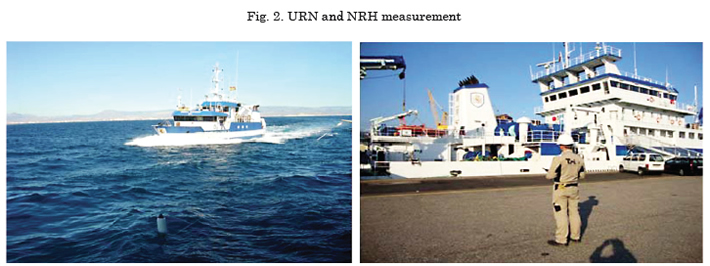
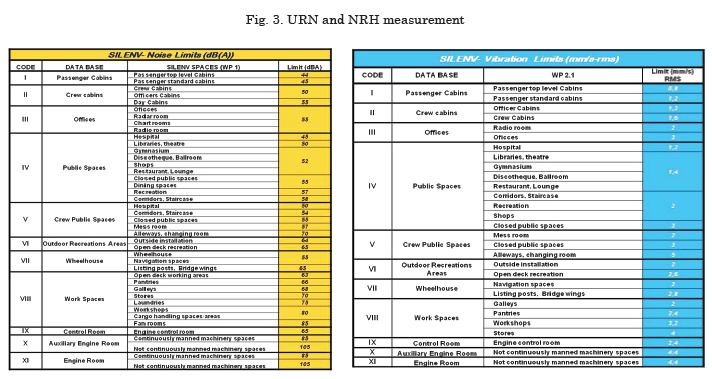
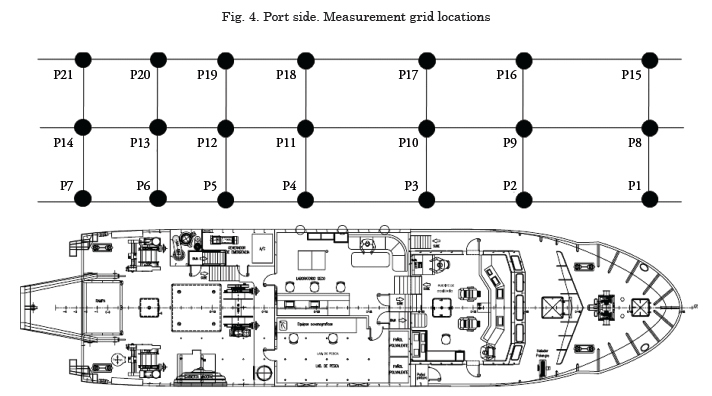
Directives, as well as of national legislation of several Member States, the preliminary targeted limits for the Noise Radiated to Harbour, for all types of vessels (in coincidence with Directive 2002/49/EC), have been the following: the noise levels (expressed as Leq db(A)) radiated by the vessel when it is berthing at a distance of 25 m from both hull sides, shall be lower than 65 db(A). To carry out these measurements, a dedicated SILENV measurement procedure has been developed. This procedure defines a grid of the measuring points at 1, 10, and 25 m, on both sides of the targeted vessel (Fig. 4).
To facilitate the corresponding assessment, the results obtained must be presented graphically in the form shown in Fig. 5.
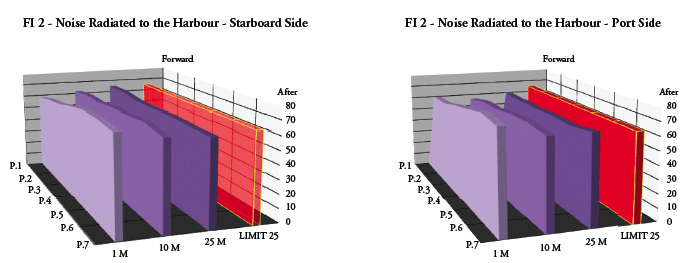
Underwater Radiated Noise Targeted Limits
As previously, after a detailed review of the state-of-the-art, a preliminary proposal for the URN targeted limits was made (Fig. 6). Regarding the URN topic, the vessels were sub-divided into two different groups: one that included Fishing Research Vessels and Fishing vessels; and another that grouped all the commercial vessels. For the first group, the URN targeted limits adopted were the wellknown ICES Nº 209 Regulation limits at 11 knots. Based on experience, these targeted limits are consistent with modern FRV needs and are technically and economically feasible. For the second group of vessels, the final URN targeted limits adopted were a combination between the ICES Nº 209 and that proposed by DNV in its optional Silent Class Notation limits. In this case, two operational conditions were adopted: SILENV-Quiet at 11 knots and SILENV-Transit at normal sea-going conditions. In all the cases, the results shall be provided in terms of pressure in dB (ref 1 μPa) in 1/3 octave band (1 Hz) referred at 1 m from both hull sides of the vessel. Using as a guideline the ANSI-ASA standard, a dedicated SILENV URN measurement procedure was established to harmonize the experimental data provided by the different participants. The propagation model adopted for the transmission lost was TL= 20 log DCPA.
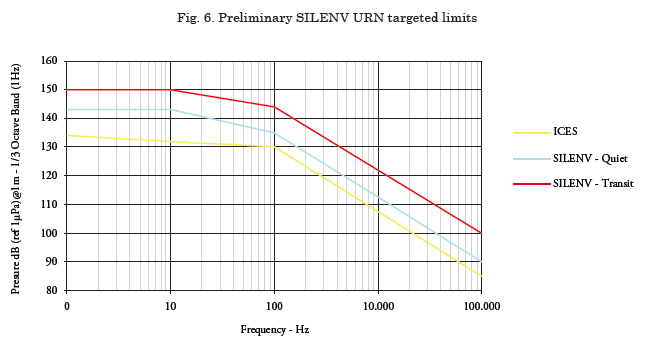
The global N&V assessment: the assessment matrix.
The Aim and Scope of the Assessment
Thus and once:
• The targeted limits related to the different topics making up the N&V-FS of a vessel have been established.
• The SILENV- N&V Database has been compiled; the assessment could now be carried out.
The main targets of the assessment are:
• Comparison of data and measurement results with the preliminary targeted limits adopted. This will permit answering the question of how far are the current different types of ships from the preliminary SILENV targeted limits.
• Root cause/s identification of the deviations detected. This second level of assessment focuses on accurately identifying not only the N&V sources that cause the N&V deviation but the technical lacks or absences that motivate the deviation observed among the different N&V topics that make up the N&V-FS, and the preliminary N&V limits.
To conduct the assessment, it has been subdivided into the three following levels or phases:
• Assessment Level 1: Comparison of ships with the preliminary targeted limits (PSL).
• Assessment Level 2. Phase 1: Effect of the N&V Control techniques applied during the design processes.
• Assessment Level 2. Phase 2: Identification of the main N&V sources as root cause/s of deviations.
Finally, this analysis has been completed with the “Sensitivity Analysis” that will provide the improvements/recommendations required to meet compliance with the targeted limits. It will consist on assessing and evaluating how the application of these blocks could contribute to building vessels that comply with the new SILENV limits, or at least as close as possible.
Thus, once the aim and scope of the assessment activities have been widely explained, the methodology used to complete this commitment will be described in the following paragraphs. In other words, what should be done and how should we do it, will be detailed step-by-step.
The Utilities developed
Based on the expertise of some partners and considering the arduous task entailed in assessing thousands of N&V experimental data coming from many vessels, at the beginning of the project the update of the dedicated “TSI- N&V Tool” was foreseen. Likewise and focused on automating the assessment process as far as possible, a whole package of dedicated “utilities” were foreseen and have been developed. These utilities are:
• The “Vessel Excel Sheet”. Its purpose is to homogenously compile the N&V experimental data, as well as the technical information from
each of the vessels. This document has been generated for all the vessels.
• The “Vessel Card”. It summarizes the main particulars of each vessel, as well as the answers to the required questionnaires related to N&V issues.
• The “Vessel Graphs”. Using the “TSI-N&V Tool” the graphical reports (one for each topic) of the N&V numerical data compared with the N&V targeted limits adopted have been automatically generated for each of the vessels in the database. In Fig. 7, the “Noise and
Vibration Vessel Graphs” of fishing vessel (FI2) (FI2 vessel is one of the many vessels compiled in the SILENV-N&V database) are reported.
Similarly, the tool organizes the information by types or families of vessels. For example, Fig. 8 shows the N&V information of the Merchant vessels.
Using this information, it is easy to conduct statistical analysis related to the distribution of the N&V levels on board regarding both the PSL and the Standard limits: IMO and ISO. This kind of analysis has been done for all the families of vessels analysed.
For the assessment of the other topics of the N&V-FS: NRH and URN, the way information has been treated was different when it came from vessels that had previous information available or from vessels that had to be measured. In the fi rst case (vessels that had previous information), due to the low availability of NRH and URN data, the assessment had to be done case by case. In the second case (vessels that had to be measured), the “Assessment Utility” generated a report like the one seen in Fig. 9.
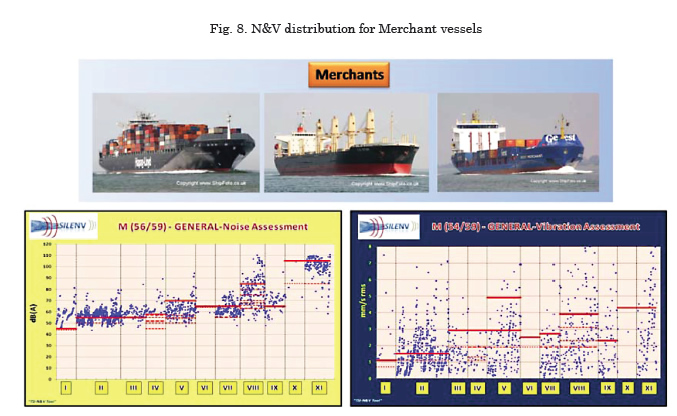
As noted, this utility that graphically summarizes all the experimental results from the corresponding “Measurement Report”, permits ding – whenever possible – the complete assessment of the N&VFS for each of the vessels comparing them with the PSL.
Th us, and using this collection of utilities, the socalled Assessment Level 1: comparison of ships with the PSL has been fulfi lled.
The Assessment Tool: Th e Assessment Matrix.
The aim of this tool was to easily summarise the results and the analyses carried out by the diff erent partners involved in this task. Due to the large number of vessels analysed and because of the scope of the assessment, the proper and suitable use of this tool (the Assessment Matrix) has enabled extracting the general conclusions. Th rough these conclusions, it may be found if the vessels comply or not with the PSL. Likewise, it has enabled identifying if the application of the technical eff orts, during the design process, could positively or negatively aff ect compliance. Additionally, the partners performed deeper analysis of the vessels under their scope. In these specialised analyses, the partners identifi ed the N&V sources causing the deviations by using the corresponding spectra. Th e general process followed is summarized in Fig. 10.
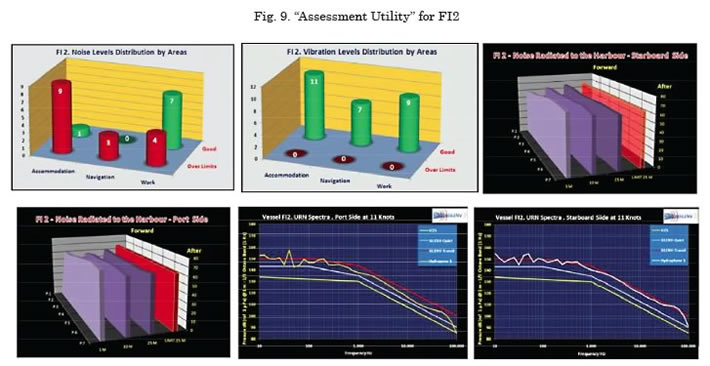
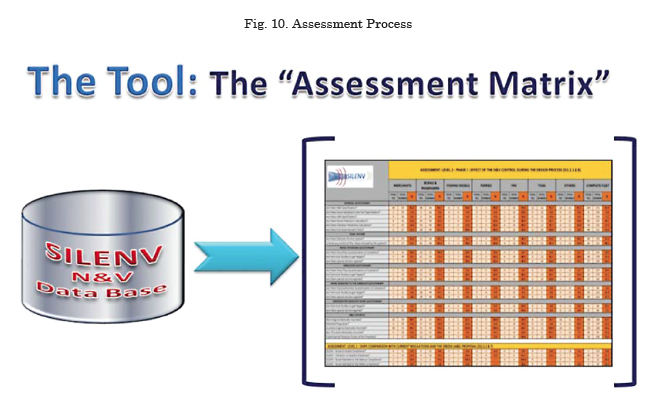
To fulfi l the targets, the rows of this Assessment Matrix have been subdivided into three diff erent sub-groups. In the fi rst column, the questionnaires that permitted studying the diff erent topics have been placed: compliance (or not) with the limits, technical eff orts applied, and identifi cation of N&V sources. Complementarily, the columns of the matrix included all the details of the vessel: type of vessel, age, partner involved, and origin (vessels that had previous information or vessels that had to be measured). In other words, all the information available on the vessels, which was processed and compiled by the previously described “utilities tools” can be found in this Assessment Matrix.
In the Assessment Matrix, the questions were answered by using a (1) (positive answer) or a (0) (negative answer). Th ese answers will permit easily carrying out a statistical analysis. Th e columns left “empty” mean there is no information available related to that particular question. By comparing the results of vessels that comply with the targeted limits to those that do not fulfi l them and correlating their particularities (N&V control activities during the design process, calculations performed, corrective solutions applied, etc.), it will be possible to develop a “Sensitivity Analysis”. Its aim is to analyse if these preventive solutions are good enough to obtain vessels that comply with the limits, or at least if they can be close to meeting these requirements.
Finally, the third group of rows is dedicated to the answers that will enable accurate identifi cation of the N&V source/s responsible for the N&V deviations detected. In this concern, it is remarkable that all the analyses have been carried out by each partner, using their own expertise and the N&V spectra.
It is assumed that in many cases, especially for vessels with previous information, the level of information provided could be limited by confi dentially agreements. Of course, this unavailability will not permit reaching full and consistent conclusions. Anyway, in other cases, this information was achieved through other questions. Th ese answers have permitted seeing the trend of the topic under consideration. Th ese trends found are supported by the information compiled on each vessel and by the corresponding Mapping Analysis made.
Assessment Results
Results of the Assessment will be summarized according to the diff erent assessment levels and phases adopted (§ 4.3 a).
Comparison of ships with the preliminary SILENV limits Assessment level 1
The status of the fleet and of each of the families of vessels that comprise it with regard to the preliminary SILENV limits adopted has been graphically summarized in Fig. 11.
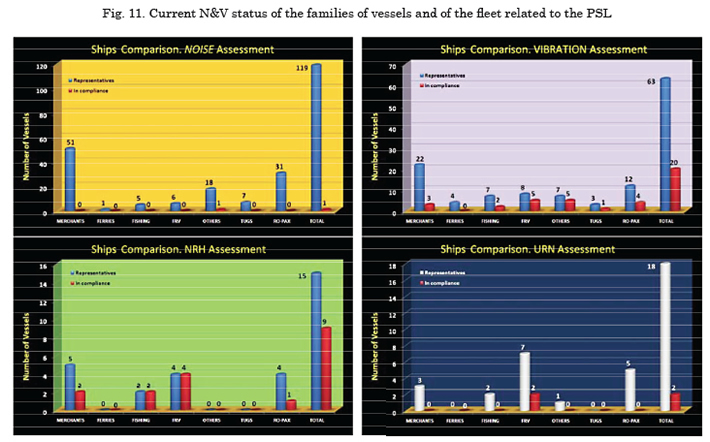
As a summary, in all the 171 vessels comprising the SILENV-N&V database none has an N&VFull Signature in compliance with the Preliminary N&V SILENV limits adopted for the different issues that compose this N&V indicator; in most cases because it has been unfeasible to assess the vessels, given the absence of dedicated data related to some issues of the N&V-FS. Likewise, and related to the 10 vessels for which the N&V-FS has been obtained by the dedicated on-site measurement activities, none fulfils the PSL adopted. Only the Fishing Research Vessel “FRV-4-TSI” is the closest vessel to fulfil it. In fact, for this vessel the vibration on board, the noise radiated to harbour, and the underwater radiated noise are in compliance with the preliminary SILENV limits, but not the Noise on board.
Effect of N&V control during the design and building process
Assessment level 2. Phase 1
The experience has permitted confirming that the achievement of vessels that are in compliance with any N&V limits established is not a question of luck but the consequence of a suitable implementation of a whole set of preventive actions focused on achieving the N&V targeted limits. These actions shall be applied conveniently and at the right time (at the early stages of the project and during its construction). The aim of this level of assessment during phase I has focused on assessing the “current trends” related to these preventive actions or efforts being applied on the different families of vessels and, therefore, on the current fleet to tackle and control the different N&V topics included in the N&V-Full Signature of each vessel. To coherently fulfil this target, preventive actions or efforts have been grouped into the following blocks:
Block 1- General Questionnaire: Has enabled assessing the presence of N&V requirements related to the different N&V topics: N&V on board, NRH, and URN in the contract specifications, as well as the extension of the use of technical preventive actions, particularly those related to the use of simulation tools and tests focused on achieving the N&V limits defined in the contract specifications.
Block 2- Technical Preventive Actions during the Early Design and Building Process: Has enabled assessing the current technical efforts developed by the different families of vessels and by the complete fleet, during the early design and building process and is focused on reaching, separately, compliance of all the N&V topics of the N&V-FS.
Block 3- Proper Selection of the N&V Sources: According to the basic principle of N&V Control Methodology the “proper selection” or, in other words, the selection of the most “silent” sources with regard to intensity, airborne and structural noise of the N&V sources is the cheapest and easiest technical way to achieve the targeted limits. Consequently, this block has enabled assessing, for the fleet under control, the right application of this previous principle. Finally, a dedicated and specific question related to the experimental pressure pulses fluctuations induced by the propeller is included. These pulses, obtained with experimental basin channel models or with the use of full-scale tests, have also been introduced. It has enabled assessing with a numerical indicator if there has been any kind of control of the main N&V sources’ intensity. Detailed analysis of these aspects would be sufficient for a paper; thereby, in the following paragraphs the most relevant issues will be summarized.
With regard to the Block 1 activities, the status found is reported in Fig. 12.
Examination of the previous figure enables highlighting the following issues:
• The requirements of Noise and Vibration on board are well extended in the current Contract
Specifications with a percentage that achieves the value of 81.9% of the total sample of vessels (171). It shows that these topics directly related to human health, working conditions of the
crew, and passenger comfort are an extended
concern for owners and shipyards.
• On the contrary, this previous trend is not observed nowadays in the current Contract Specifi cations of the vessels with regard to the noise radiated by them to the outside. In fact, from the total number of vessels in the sample (159) that could be analysed, 3.8 and 3.1% of them included specifi c NRH and URN requirements in their Contract Specifi cations, respectively.
This fact, related to the low presence of NRH and URN requirements in the specifi cations of the current vessels, may be seen as logical if we consider that these topics are quite new. All the new environmental regulations are quite recent, but will be compulsory shortly.
• Focusing attention on the spread of the use of simulation tools: N&V Prediction Calculations, as technical preventive actions focused on achieving vessels that comply with the N&V requirements, it is an outstanding fact that only 38.7% of the vessels have a Noise Prediction calculation and only 37.4% have a Vibration Prediction calculation, which clearly shows a very poor level of spreading.
In relation to Block 2 of the technical preventive actions and, particularly, with those related to the HVAC system (identifi ed as one of the main root causes of noise on board), the statistical analysis shows that only half the vessels from the sample have adopted preventive actions like installation of silencers or other preventive control actions on this system. It is highlighted that only in the family of Ro-Pax and Passenger vessels these preventive actions are widespread. Th is is a clear and consistent indicator of how concerned the owners of these types of vessels are, not only about compliance with noise limits in all the cabins but also in open spaces for recreation.

The assessment results related to the rest of the technical preventive actions included in Block 2 under the general denomination of Questionnaires with regard to each of the topics of the N&V-FS: N&V on board, NRH, and, URN show a wide variety of solutions.
Regarding N&V on board, given that both topics are included in the same package of the contract specifications, the results obtained are quite coincident. Indeed, for the sample of vessels analysed (171) the percentage of them that employ simulation tools or technical studies focused on complying with the Noise and Vibration requirements achieves values of 32.9% for noise and 31.6% for vibration, respectively.
Regarding NRH, the assessment results obtained for a sample of 84 vessels show in, general, that vessels do not apply technical studies and technical solutions to combat their outdoor radiated noise, with the only exception (only 26.4%) of Passengers and Merchant vessels. Similarly, and related to URN, only 10.2% of the total sample of vessels analysed (88) have reported using dedicated simulation tools as, well as the application of dedicated technical solutions to achieve compliance with URN requirements (in those exceptional cases were they are required) or on minimising their underwater footprint impact. Th e biggest contribution to this result is made by the fi shing research vessels, which is also starting to be observed in passenger vessels.
These results related to the application of dedicated techniques and solutions to combat the NRH and URN impact of the vessels is a direct consequence of the identifi ed absence of specifi c NRH and URN requirements in the contract specifi cation, already refl ected in Fig. 12. Th ey obey the basic principle of “nobody will do something if they are not forced to”.
Finally, the assessment results related to the Technical Preventive Actions included in the Block 3- Proper Selection of the N&V Sources and focused on reducing or minimising the intensity of the excitation forces or the noise induced by the diff erent main N&V sources: machinery and propeller, etc., that have been adopted during the early design of the vessels are summarized and reported in Fig. 13.
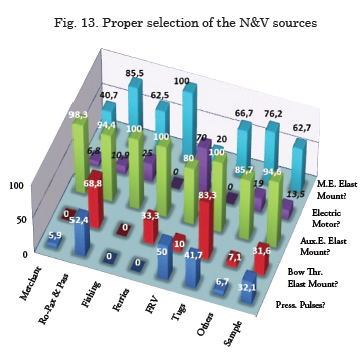
It is assumed that in most cases, until now, the selection, primarily of the main machinery and propeller, has been related to fuel consumption and to economic aspects of exploitation of the vessel. On the other hand, if vessels wish to comply with N&V requirements and especially want to abate their underwater footprint, it is possible that the previous selection could be aff ected and limited in some aspects. Th erefore, for the propulsive and economic aspects it will be necessary to add new criteria and make a sensible balance between them. It must never be forgotten that according to the experience, nowadays the right selection of the N&V sources is the cheapest way to achieve the N&V targets. When these preventive actions are not possible to be carried out, care should be taken related to the proper insulation of the transmission paths. So, the aim of the assessment of this Block 3 of activities is to know how widespread are the preventive actions focused on minimising the incidence of the N&V sources, within the current fleet.
Examination of the previous Fig. 13 enables highlighting the following aspects:
• As noted, elastically mounting the main engines is an extended countermeasure to minimise their infl uence in N&V, within the current fl eet, with an average value of 62.7% (169 vessels have been analysed). All the families, except the merchant and fi shing research vessels, are over this average. Th e deviations for these two families of vessels are related to the use of two-stroke diesel engines, for the merchant vessels, and to the use of an electric motor rigidly connected to the hull, for the fishing research vessels.
• In relation with the topic of the use of electric motors, it is clear that this type of propulsion is not as widespread within the current fl eet, only 13.5% of the sample of 171 vessels uses it. Th e vessels that use them more are those with the most restrictive URN requirements like fi shing research vessels. Electrically driven propulsion is implemented in 70% of the FRV. The other families of vessels do not use this solution very much.
• With regard to the use of elastic mounts on the auxiliary engines, the high value obtained, 94.6% (168 vessels were considered), enables us to state that this preventive solution is a very well widespread standard within the current fleet.
• The bow thrusters have usually been identified among the main noise sources when they are operating, during the berthing and unberthing transient periods. Based on the expertise of some partners, and due to the unavailability of experimental data that enables properly characterizing this source, a double skin design is recommended. Th is design has proven to be a useful preventive solution to reduce their impact.
• Finally, with regard to the use of pressure pulse fl uctuation measurements through basin channel models, as an approach to estimate and control the intensity of the excitation forces induced by the propeller, this measure is very poorly spread (32.1% of a sample of 106 vessels). As seen, the major contribution came from passenger, FRV and tug vessels, respectively.
Identification of the root cause/s of the deviations detected
Assessment level 2. Phase 2
The numerical assessment related to identifying the root cause/s of deviation of N&V on board, NRH, and URN compared with the PSL has been reported and it has been separately done for each of the families of vessels, as well as for the entire fleet.
Finally, a general picture of the fl eet with regard to the root causes of the deviations is depicted in Fig. 14. Examination of Fig. 14 and of the numerical assessment results obtained enables highlighting the following aspects and conclusions:
• With regard to noise on board, the main engine, the HVAC system, and the propeller/ thrusters have been identifi ed as the major root cause of noise deviation with regard to the PSL.
• Related to vibration on board, the propellers and the main engines appear to be the main sources of vibration that cause the deviations with the PSL. Th is fact is also seen in other topics, but it does not mean that it could be extended to other topics, for example URN.
• The exhaust of the main and auxiliary engines, as well as the inlet/exhaust ventilation systems, has been identifi ed as the main factor responsible for the deviations of the outdoor radiated noise when compared with the PSL.
• The machinery and the propeller, especially when cavitation appears, have been identified and, in this order, as the major root cause/s of the deviations detected in the noise radiated by the vessel into the water with regard to the preliminary URN targeted limits. This approach is consistent enough with the experience documented at Glacier Bay, mainly related to passenger vessels.
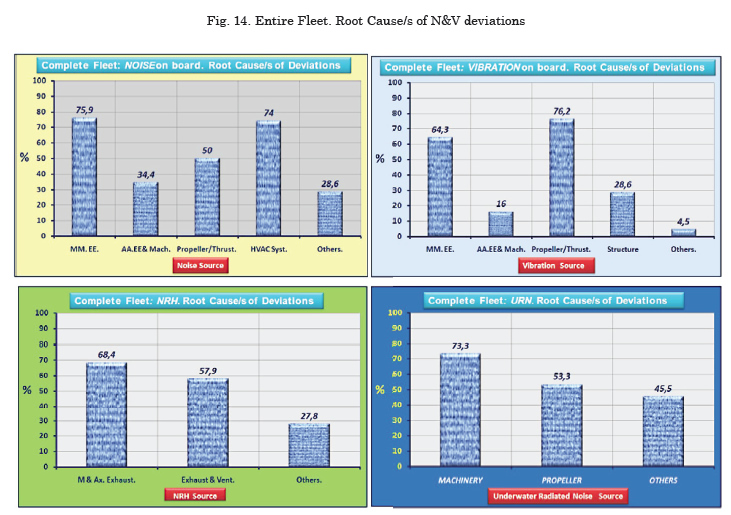
Additionally, and based on these results, experimentally well-supported and in clear contradiction with the general and well-extended assertions (but with no experimental or consistent data to back them), it would be recommendable to completely review them to find a new starting point that will enable us to look forward together (scientific community and marine sector), for solutions that could improve the current state.
Sensitivity analysis to achieve the preliminary n&v targeted limits adopted
The “Sensitivity Analysis” carried out within the framework of the SILENV project is aimed at identifying the improvements or complementary technical efforts required to achieve compliance with the preliminary SILENV targeted limits. The main steps and the strategy followed to develop this dedicated activity of “Sensitivity Analysis” were the following: in a first step, the “numerical gaps” or deviations among the experimental numerical N&V on board, NRH, and URN values measured in the different families of vessels and the preliminary SILENV targeted limits were obtained. Complementarily to this analysis, in a second step, the “numerical gap” or deviation among these values and the standard IMO and ISO limits (or any other limits) were also obtained.
Once these numerical gaps have been identified and the dedicated technical efforts done by each family of vessels, and so by the fleet, are well known, the “deficits” in terms of technical efforts will also be identified. So, based on these “deficits”, it will be possible to advance, as a first approach, in the complementary efforts and technical improvement solutions that should be required to get close to the preliminary SILENV targeted limits.
Noise & Vibration statistical numerical deviations
The statistical analysis, for each family of vessels, was made by comparing the N&V numerical values available, from each main space, with the following limits: Current Regulation Limits (IMO A.468(XII) Regulation, for noise and ISO 6954 (2000), for vibration); upper and lower preliminary SILENV limits for each space.
In each graph and for each space, the targeted limits used and the “average value” of the sample of available data are reported. Likewise, the percentages of deviation for each space over the predefined limits are also reported. As explained previously, these graphs (N&V) were obtained for all the families of vessels.
Current fleet. Sensitivity analysis of the change of N&V limits
In a first step, (to characterise the entire Fleet) and based on the previous results, the Maximum and Minimum percentage deviations of N&V regarding the current N&V limits and the upper and lower preliminary SILENV N&V limits were obtained. In fact, this information becomes a consistent indicator of the status of the current fleet with regard to these N&V limits. In fact, and as previously mentioned, the particular N&V deviations for each family of vessels is comprised in the area bordered by those Maximums and Minimums. These results are summarized in Fig. 15.
Examination of the previous Fig. 15 and analysis of the results obtained related to the Sensitivity Analysis for the current fleet with regard to the different noise limits: standard current limits (IMO) and the PSL, has enabled us to highlight the following aspects:
• For all the families of vessels analysed, in some of them and at some spaces, the general percentage trends of noise level deviations with regard to the current noise IMO A-468(XII) standard achieves values of 100%. For these families of vessels and consequently for the whole current fleet, independent of compliance by some particular vessels, compliance of the noise levels with any other more restrictive noise limit like the preliminary SILENV is not feasible.
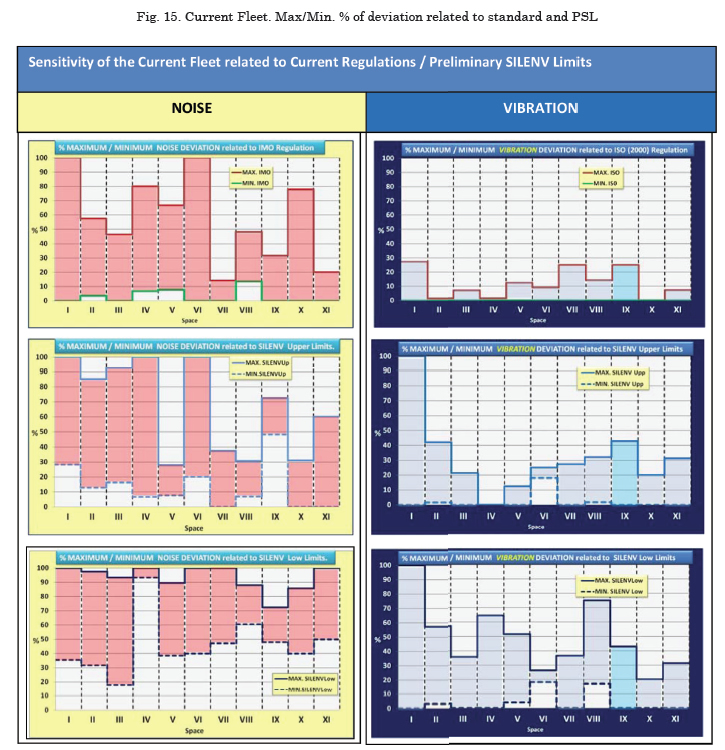
Likewise, examination of Fig. 15 and the results related to the Sensitivity Analysis of the current fl eet with regard to the diff erent vibration limits: current standard ones (ISO 6954 (2000)) and the Preliminary SILENV vibration limits, enables us to highlight the following aspects:
• In general terms, and as far as the vibration levels are concerned, the current fleet is close to complying with not only the current ISO 6954(2000) standard but also with the preliminary SILENV vibration limits. Th e same cannot be said for compliance with the noise levels of the IMO standard and with the preliminary SILENV noise limits.
• In fact, different families of vessels exist that not only comply with the ISO standard vibration level, but which almost comply with the preliminary SILENV vibration limits in nearly all spaces.
• Thus, compliance with the vibration limits of the ISO standard and of the PSL could be more achievable than compliance with the noise limits.
• The results obtained from the Sensitivity Analysis with regard to the change of the vibration limits clearly show that the current situation could improve (the deviation) if the preliminary SILENV vibration limits were raised slightly. By doing this, we will have more permissive limits, but they will still be very demanding. In any case, full and strict (at all spaces and with no deviations) compliance could be achieved.
Cross comparison: efforts compared to the N&V results. Unitary model approximation.
From the authors’ point of view, and taking into account their expertise (they have dedicated many years to the design of vibration-free and silent vessels [6]), the following idea has to considered: “Compliance of a vessel with any N&V limits is the result of the proper application of a whole set of tailor made efforts and technical solutions. These must be well-pondered and applied at the right time/stage of the project”.
On the other hand, the activities developed within the framework of the assessment related to the effect of N&V control during the design process §5.2, has permitted noticing that some “deficits or lacks in the technical efforts” exist that will hinder the final objective of complying not only with the PSL but also with the IMO Standard and with the ISO Regulation.
Consequently, the aim of the new sensitivity analysis, in terms of efforts applied, has focused on answering the following two key questions:
• What has been done until now, in terms of technological efforts, in the different families of vessels of the current fleet in order to abate N&V?
• What additional efforts and technological solutions should be applied to the new constructions in order to reduce their environmental impact?
As a result of this “Sensitivity Analysis” that will be expressed in terms of Δ of Percentage (%) of Compliance with the N&V limits by unitary effort applied, the lack of efforts required to achieve compliance with the Standard Regulation could be estimated and, consequently, the additional efforts and technical improvements the new constructions need. The previous analysis was made separately for each of the different N&V topics included in the N&V-FS. The results obtained were summarized in the following way:
Noise on board
The total technical efforts applied (for the complete fleet) to abate noise on board and, therefore, achieve full compliance are 49.8%. The efforts are logically not applied in the same manner in every family. Passenger vessels and ferry vessels are the families applying the maximum efforts.
Related to this topic, the sensitivity analysis enables stating that full compliance with the IMO standard and with the upper PSL will be achievable and it would only require the promotion of the following different dedicated activities, organised by Blocks:
• Specifications: Making it compulsory for noise requirements to appear in the entire contract specifications.
• Simulation Tools and Test: Fully applying all these dedicated activities: noise prediction calculations and technical studies.
• Noise Source Control: Improving the activities of this block, especially the generalisation of the HVAC silencers, HVAC control, elastic mounting of the main and auxiliary engines, and installation of elastically mounted thrusters.
• Engineering Solutions: Taking into account the current “State–of-the-art”.
Compliance of the current fleet with regard to the “strict application” of the strictest lower PSL is not achievable. The approximation made with the Unitary Model has permitted estimating that this compliance would not be reachable even if additional “improvements” were made. In fact, all the activities of the different blocks (specification, simulation tools and tests, noise sources control and engineering solutions, additional technological improvements of the solutions) should be implemented if we want to achieve those limits.
Among others, as “Technological Improvements” the following could be mentioned: replacement of noisy sources by other silent ones; for instance, main propulsion based on electric motors instead of diesel engines; special and dedicated design of elastic suspensions to minimise structural noise contribution; encapsulation of the main noise sources, etc. As previously mentioned, for all the cases, the costs/benefits ratio shall be assessed.
Vibration on board
The total technical efforts applied for combating this topic are 45.4% of the total efforts required to reach full compliance. Passenger vessels and ferry vessels are the two families applying the maximum efforts.
Similar to what happened in the case of noise on board, particularly to the efforts made to comply with the current ISO-6954 (2000) Standard and with the preliminary SILENV Upper and Lower Vibration Limits, it must be stated that they are not fulfilled.
Anyway, the high percentage values of compliance identified are a good indicator of the efficiency of the efforts currently applied by the shipbuilding industry to minimise the impact of this topic.
In general, full compliance of new vessels could be achievable if the proper corrective actions were applied. As noted through the previous analysis, achievement of the targeted vibration limits for the new constructions is conditioned by the application of the dedicated activities included in the following blocks:
• Specifications: Making it mandatory for vibration requirements to appear in the contract specifications of new constructions.
• Simulation Tools and Tests: By reinforcing and, in some cases, including it as a requirement in the specifications of the development of Vibration Prediction Calculations and Technical Studies required in achieving the targeted limit required.
• Vibration Sources Control: In general, reinforcement of all the activities within this block and focused on minimizing the excitation forces induced by the different vibration sources, especially the propeller.
• Engineering Solutions: In some families of vessels, these activities should also be reinforced to make up for the lack of available silent and competitive supplies in the current market.
Noise Radiated to Harbour (NRH)
Related to this novel N&V topic, the technical efforts currently applied by the fleet are 19.2% of the total required, which is a very low value. The low trend of technical efforts deployed by the fleet to confront this disturbing topic is directly related to the entire absence, as it has been proven, of specific requirements in the contract specifications of most of the current vessels, including the most modern ones. Only those owners that have been occasionally affected by these complaints are starting to include these specific requirements in their contract specifications. Once again, the principle “no one does anything if they are not forced to” is confirmed.
Thus, despite the appearance of the Directive 2006/87 EC [2], the presence of these types of requirements is still strange, if we consider that this regulation has recently become compulsory. Furthermore, from the authors’ point of view, there is no harmonisation in the different limits. Moreover, its application changes from one member state to another, in fact, it can change from one harbour to another within the same country. Consequently, the corrective actions that should be implemented to improve this situation could be, among others, the following:
• The Cost/Benefit (very low ratio) of applying these kinds of solutions during the early stages of the project should be disseminated.
• Improvements related to the harmonisation of applying Directive 2006/87 EC in all the member states should be considered.
• To apply the most suitable noise management of the harbours, the current NRH signature of the current fleet should be obtained, independent of its compliance or not with the standard limits. It will enable placing the vessels in the best locations, taking into account the disturbance they produce.
Despite the small size of the sample of available vessels analysed, but based on the authors’ experience and on the case studies available [7], it could be stated that compliance with the PSL could be achievable for all the families of vessels that make up the current fl eet. As seen with the previous analysis, if we expect for all the new constructions to comply with the targeted NRH limits, the following activities should be applied:
• Specifi cations: Making it mandatory for NRH requirements to appear in the contract specifi cations of new constructions.
• Simulation Tools and Tests: Generalising the demand for technical studies in the contract specifi cations. Th ese technical studies will provide reliable outputs only if the sources introduced are well-known; hence, it would be vital to control these sources and have their complete characterisation.
• NRH Engineering: Based on the results obtained through these studies, the most eff ective technical solutions shall be applied.
Underwater Radiated Noise (URN)
With regard to this also novel N&V topic, the fi gures related to the eff orts currently applied by the diff erent families of vessels and by the current fl eet are reported in Fig. 16. As noted, the total technical eff orts applied by the fl eet to address this disturbing N&V topic achieve a value of 30.9%.
Likewise, the fi shing research vessels appear as the family of vessels deploying the maximum relative eff orts (45.7%) for abating their underwater footprints, followed by passenger vessels that seem to be increasingly more concerned about this topic. Related to the eff orts applied by the rest of the families of vessels, these results could be described as deceitful. In most cases, these families have centred their attention on abating N&V on board, but have not done the same with the URN. Th erefore, if they want to solve their underwater footprint problem, they will have to face the problem in a comprehensive way.
As explained before for the case of NRH, the disappointing results observed in the application of technical eff orts on the European fl eet (not considering the FRV family) could be explained because of the absence of URN requirements in the contract specifi cations of most of the current vessels. Even the most modern ones do not pay attention to this disturbing topic and do not include these requirements in their specifi cations. Another crucial fact from the authors´ point of view is the confusing scenario that exists in the marine sector.
On one side there is an increasing concern from the scientifi c community about the damage in marine life. On the other side, the shipbuilding and marine industry needs more information about the cost/benefi t ratio that will suppose for the sector the upgrade of all the commercial vessels. Another pending matter is that, until now, no one has assessed, in terms of cost/benefi t, the impact of the underwater footprint of the vessels. Furthermore, there is no agreement on how the measurement procedure should be, on which should be the new URN limits for each family of vessels (based on experimental information), or on how to apply these solutions.
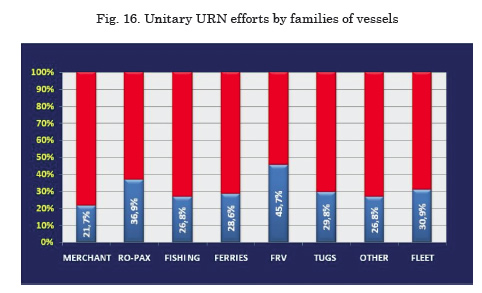
Within this confusing scenario (well-described and detailed by the authors in reference [6]), if we want to move ahead, it will require establishing a well-defined policy or strategy. This policy should “convince and not only obligate”. The right way for doing this would be:
• Dissemination of dedicated activities to abate this URN topic shall be launched within the marine sector and the technician community.
• Once the current URN framework has been pictured, the SILENV project has described the current situation of the fleet (in relation to its compliance with the PSL) and the impossibility to apply retrofits to all the vessels of the fleet (to improve their degree of incompliance) is accepted, potential solutions should be found:
- In the short term, it would be necessary to significantly improve the current state. Proper Underwater Radiated Noise Management is essential, but it will require knowledge of the current fleet’s URN signature, independent of its compliance or not with the standard limits. Combined with the information provided by the AIS system, it will enable evaluating if a vessel could enter or not a protected area. As a first step, a rough approach could be made based on experimental information such as the one provided by the SILENV project.
- Harmonisation of the measurement procedure and agreement between the scientific community and the marine sector on the definition of the preliminary URN limits should be promoted. At this stage, these preliminary targeted limits may not be the perfect ones, related to the threshold of all the marine species, but they will be enough to improve the current state. It will enable the marine sector to assess the technical viability of these design changes and the economic consequences.
- Currently, with some exceptions, the owners do not see the costs/benefit related to the investments required to reduce the URN impact of their vessels. From the authors’ point of view, the EC authorities, currently worried by the increase of noise in the oceans, have established the right policy that will enable incorporating in the marine sector, hardly affected by the economic crisis, this new challenge related to the reduction of the underwater footprint of all the vessels.
From a technical point of view, full compliance of “new vessels”, similar to those that make the current fleet, with the PSL could be achievable. This could be done if the proper and right actions were applied during the earlier stages of the design of the new vessels. These preventive actions could be summarized in the following blocks:
• Specifications: Making mandatory the presence of specific URN requirements in all contract specifications of new constructions.
• Simulation Tools and Tests: Generalizing the requirement of technical studies to achieve the targeted limit in the specifications. It must be taken into account that to have good results from the simulation tools, these depend on the quality of the information. Therefore, the intensity of the sources must be well known and the suppliers must provide reliable information that should be controlled by means of FAT.
• URN Sources Control: All the preventive actions related to N&V sources, which for most of the cases are the same as for the URN sources, and which are focused on abating the corresponding topic, noise or vibrations, respectively, are not enough to abate the URN signature of the vessel. It means that the conventional and well-extended preventive solutions have to be significantly improved to reduce the intensity of the sources and their impact on the hull of the vessels. In this sense, the use of main propulsion based on electric motors, instead of diesel propulsion, could be considered in some cases.
• URN Engineering: Depending on the type of vessel, and based on the previous points and on the theoretical results, the most effective technical and economic solutions should be sought.
Finally, it is important to consider that all these preventive actions grouped into blocks and recommended to address the different topics included in the N&V-FS are based on the authors’ documented experience.
Indeed, there are many vessels that have applied these preventive solutions, proposed by the authors, which comply or are quite close to complying with the strict PSL. These vessels belonging to different families became a milestone and must be seen as “technological references” [6].
Conclusions
Based on the analyses made and on the results obtained, the following conclusions could be highlighted:
• The SILENV-N&V database, compiled under the framework of the SILENV project, became the largest ever N&V database in the marine sector, as well as a complete novelty. Therefore, the results, conclusions, and recommendations obtained from its assessment, not only related to N&V on board but also with regard to outdoor noise radiated by the vessels, could be of paramount importance to support current EC policies and other marine institutions that focused their efforts on reducing the environmental impact of the ships.
• The complete assessment, as well as the sensitivity analyses carried out enable highlighting the following points:
- Within the current fleet, there is complete and generalised absence of specific NRH or URN requirements in the contract specifications. Even the new vessels do not include them in their specifications. Only the modern fishing research vessels have specific URN requirements, but not NRH ones.
- Likewise, and due to the average age of several families of vessels (particularly the fishing vessels), N&V on board requirements are also scarce in the contract specifications.
- Consequently, and due to the lack of information, the complete environmental impact of the fleet is not assessable. Anyhow, due to the experimental information provided by the SILENV-N&V database, the environmental assessment of at least 20 vessels (belonging to different families) has been completed. The conclusions obtained could be consistently extrapolated to the rest of the fleet.
- As a direct consequence of these critical absences of specific environmental requirements and also because “nobody will do something if they are not forced to”, the technical efforts applied by the fleet to minimise the environmental impact have been limited. Even the vessels that have N&V on board requirements do little. Obviously, less is done when we refer to outdoor noise (to the air and into the water) radiated by the vessels.
- On the contrary, the modern fishing research vessels that have specific URN requirements in their contract specification are the only ones using a specific strategy of application of technical efforts focused on minimising their underwater footprints. It has been noted and it is remarkable that they comply with URN requirements (ICES Nº 209), and with N&V standards (IMO and ISO); in fact, if a little more were done they would comply with the PSL.
• After analysing the previous information and using the statistical assessment made, related to N&V on board, it could be stated that strict compliance (at all spaces and with no deviation) of all the current fleet (independent of the compliance of some particular vessels) with IMO and ISO is not achievable. Likewise, if any other stricter limits were defined, higher percentages of deviations would be found.
• Based on the results of the SILENV-N&V database, it has been proven that compliance with any N&V limits established is the direct consequence of the suitable application of a whole set of preventive actions focused on achieving the targeted N&V limits. These preventive actions shall be applied conveniently and at the right time (at the early stages of the project). Indeed, these vessels that have applied them correctly have become “technological references” that could be used as “practical guides” for the construction of the future “silent vessels”.
• Thus, from the authors’ point of view, the strategy that should be followed includes:
- Intense dissemination of the dedicated activities focused on abating the environmental impact of the vessels.
- Regarding the old current fleet and considering that retrofitting to improve the current environmental impact of the old vessels is not technically and economically feasible. Only two potential alternatives could be considered: First, launch a debate related to the renewal of the fleet and, second, apply a convenient Noise Management Policy, as the one described in the paper.
- Regarding the construction of the future “silent vessels”, the recommendations launched in the paper and based on the successful results obtained [6], when properly applied, should be clearly defined and included as mandatory in the contract specifications of the new vessels.
• Last but not least, and in clear coincidence with the authors’ point of view, the policies launched separately by the EC related to achieving vessels with “Zero Emissions” and vessels with “Green Card” notation (with minimum N&V environmental impact) should be conveniently engaged and harmonized.
Acknowledgements
The authors wish to express their gratitude to all the partners of the SILENV project: DCNS, BV, SSPA, CETENA, UPC, ACCIONA, UNIGE, UGS, CEHIPAR, TNO, VTT, and HTP-UV. Gratitude is also extended to the End-User Group: IEO, SGM, VIKING LINES, ACCIONA, PORT OF GENOA, SHELL, and STENA LINE. Without their cooperation, this paper would not have been possible.
References
[1] DIRECTIVE 2003/10/EC “Minimum health and safety requirements regarding the exposure of the workers to the risk arising from physical agents (noise)”.
[2] DIRECTIVE 2006/87/EC. ”Laying down technical requirements for inland waterway vessels and repealing Council Directive 82/714/EEC”. 12th of December 2006.
[3] DIRECTIVE 2008/56/EC. “Establishing a framework for community action in the field of marine environmental policy (Marine Strategy Framework Directive). 17th of June 2008.
[4] IMO RESOLUTION A.468 (XII). Code on noise levels on board ships. Adopted on 19 November 1981.
[5] INTERNATIONAL STANDARD ISO 6954-1984. “Mechanical vibration and shock- Guidelines for the overall evaluation of vibration in merchant ships”.
[6] PUBLIO B. /J.I. DIÁZ /R. SALINAS. “Achievement of the new underwater RADIATED NOISE requirements by the Spanish shipbuilding industry. The FRV “Ramón Margalef”.
[7] PUBLIO BELTRÁN. “Shipbuilding and new requirements to reduce the environmental impact of ships: New technological challenges and business opportunities”. Ship Science and Technology, Vol. 5 -nº 10. January 2012. (www.shipjournal.co).